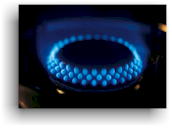

Sizing
Technology Options
User Tips
Cost-Effectiveness Assumptions
Using the Cost-Effectiveness Table
Sizing
Selecting an oversized gas water heater, besides raising purchase cost, will result in
increased energy costs due to excessive cycling and standby losses. ACEEE’s Consumer
Guide and GAMA’s Consumer’s Directory provide good, simple guidance on proper
sizing of water heaters. The “capacity” of a gas water heater should be judged
by its first hour rating (FHR), not its tank size. Due to larger burners, some gas water
heaters with smaller tanks actually have higher capacities (FHRs) than models with larger
tanks.
 |
Technology Options Where hot water demand is small, one cost-effective option is a “demand” (tankless) gas water heater. However, these can provide, at the most, only four to five gallons of heated water per minute (for reference, most showerheads draw about three gallons per minute; faucets usually draw between two and three gallons per minute at full capacity). “Indirect” water heaters, which employ a tank but use the building’s boiler (or furnace) to heat the water, can be an energy-saving option, especially if the boiler or furnace is an efficient one. Some “integrated” models feature both hot water and space heating functions in the same compartment. Depending on the climate and energy prices, a solar-assisted water heater may result in substantial energy savings. |
User Tips
Energy costs increase with higher water temperature settings; set the temperature at the
lowest temperature that allows for sufficiently warm water, usually 110 degrees F to 130
degrees F. Turning gas water heaters down or off during vacations will save significantly
on energy costs, also; if turned completely off, however, the pilot must be relit upon
return.
Cost-Effectiveness Assumptions
Annual energy use in this example is based on the standard DOE test procedure and is
calculated assuming an inlet water temperature of 58ºF, a water heater temperature
setpoint of 135ºF, daily hot water demand of 64 gallons, and 365 days per year of use.
The assumed gas price is 40¢ per therm, the federal average gas price in the U.S.
Gas Water Heater Cost Effectiveness
Example |
|||
| Performance | Base Model | Recommended Level | Best Available |
| Energy Factor | 0.54 | 0.61 | 0.65 |
| Annual Energy Use | 277 therms | 246 therms | 230 therms |
| Annual Energy Cost | $111 | $98 | $92 |
| Lifetime Energy Cost | $1,200 | $1,050 | $1,000 |
| Lifetime Energy Cost Savings | - | $150 | $200 |
Using the Cost-Effectiveness Table
In the example above, a gas water heater with an Energy Factor of 0.61 is cost-effective
if its purchase price is no more than $150 above the price of the Base Model. The Best
Available model, with an Energy Factor of 0.65, is cost-effective if its price is no more
than $200 above the price of the Base Model.
Source: U.S. DOE, Federal Energy Management Program
|
|

|
| Copyright Aclara Technologies LLC. All Rights Reserved. | |